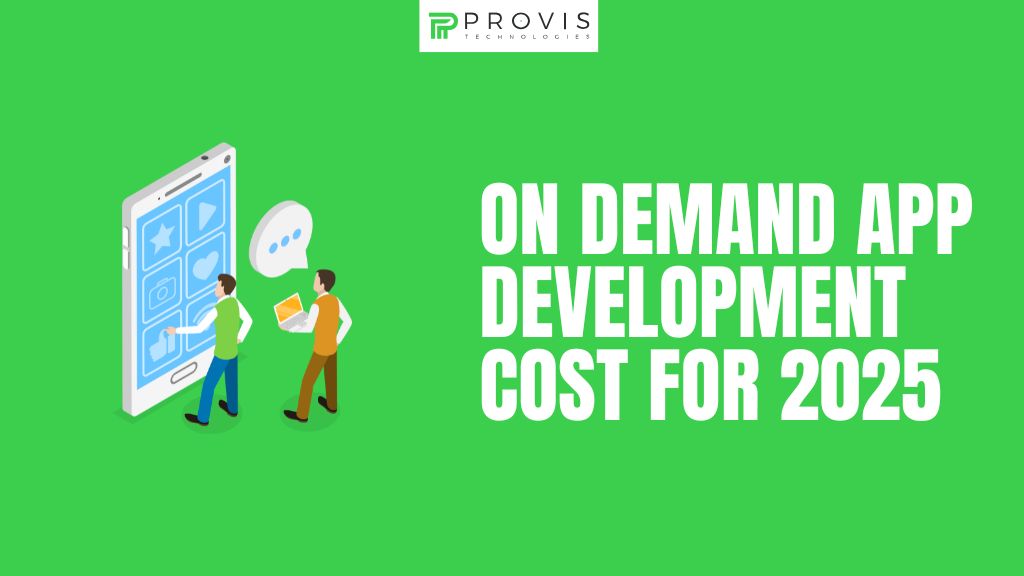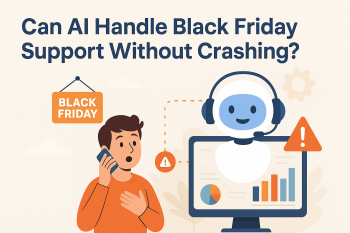Have you ever thought about how certain on-demand applications appear to pop up overnight and gain immediate popularity? The reason often lies in strategic development processes and, yes, budget.
Whether it’s food delivery, transport, or shopping, such on-demand apps are transforming how we live and connect. However, this seamless experience has a lot to do with crucial development parameters and cost elements that can make or break the entire end result.
In this guide, we will explain how much it will cost to develop an on-demand application in the year 2025, exploring what makes these projects pricey!
Let’s get started!
What is an On-Demand App?
On-demand applications have one focus – connecting individuals to services – at the right time. This involves connecting consumers who wish to use a service without delay to a provider willing to do so to eliminate waiting time and add more comfort. Rather than the conventional employer-employee arrangement, these applications primarily function as intermediaries between clusters of customers and independent service providers, enabling both to interact under flexible and beneficial terms. This kind of application lets users request various services, usually with a few taps on their smartphones instantly.
Whether it’s food delivery or ridesharing, there are apps from Uber to Zepto and Swiggy Instamart that have changed our daily living needs. These platforms bring improved customer service to the next level by focusing on convenience, speed, and flexibility.
Types of On-Demand Apps
Here are some types of in-demand apps that we consistently use in our daily lives –
| Category | Examples |
| Consumer Goods | AJIO Online Shopping, Meesho |
| Crowdfunding | Kickstarter, Patreon, GoFundMe |
| Education | Udemy, Unacademy |
| Recruiting | Indeed, Glassdoor |
| Delivery | Swiggy Instamart, Blinkit |
| Food | Zomato, Swiggy |
| Transportation | Uber, Ola, Rapido |
Why Are On-Demand Apps Popular?
In the present times, on-demand applications are quite popular as they satisfy the needs of the user at any particular moment and make the world so easy with a mere click. The increased adoption of mobile technology by users has also increased the demand for on-demand apps.
In fact, the on-demand application market is expected to grow more than one trillion dollars by the year 2027, with an annual increase of 44%.
Key Steps to On-Demand App Development
Creating a successful on-demand app involves careful planning and strategic choices. Here’s a quick guide through the essential steps:
Step 1: Do Thorough Research
Even before the development stage starts, carrying out proper research is important. Coding is meant to guarantee that the app will work as it is supposed to, but understanding the target audience’s motivations and needs makes a difference in the way the app is used by the people it is made for. Determine the challenges, the wants, and the markets that will help develop the app in a more appealing way.
Step 2: Define Essential Features
Concentrate on what will make your application stand out and describe the features your app will need. Do not just duplicate applications that already exist; instead, include additional features that are consistent with your goals as well as your intended audience. Depending on the type of the application, features can also include user profiles, real-time tracking, and many more.
Step 3: Choose the Right Development Team
Finding an appropriate tech partner is of utmost importance.
- In-house teams are the best option for continuous support in complex and long-term projects, though they can be expensive.
- Having an outsourced team offers cost-efficiency and is suitable for short-term as well as long-term needs.
Step 4: Decide on a Technology Stack
Selecting the right tech stack is crucial –
- Mobile: Swift for iOS, Kotlin for Android, or cross-platform options like React Native or Flutter.
- Web: React.js is for the front end, Node.js or Django is for the back end.
Step 5: Develop and Launch an MVP
A minimum viable product (MVP) is useful for testing the market. Introduce a simplified version of the product to obtain constructive criticism, improve the idea and draw initial customers. After this has been done successfully, re-channel into a complete system.
On-Demand App Development Costs
Cost depends largely on the complexity and customisation level –
Basic Apps
When it comes to uncomplicated, simple, on-demand applications with standard features like navigation, search, or scheduling, the costs generally vary between $10,000 and $40,000. These are simple, purposeful applications aimed at tackling the basic needs of the user adequately.
Moderate Apps
Integrating features such as user login, customisable profiles, and chat systems into any website increases the budget from $12,000 to $50,000.
Complex Apps
Developing on-demand applications with advanced on-demand functionalities such as AI integration, custom back-end systems, or data analysis may go from $20,000 to $100,000 and beyond. These sophisticated applications offer a broad range of features and are built with the necessary scalability and suitability for bigger platforms.
Factors Affecting the Cost of On-Demand App Development
Creating an app on an on-demand basis includes several cost factors, all of which contribute to arriving at the final budget. Here is a brief look at a few of the major ones:
User Interface/User Experience (UI/UX)
To retain users in the long run, a good UI/UX design is of utmost importance. This will comprise appealing visuals, functional smooth shifting across the application, and simple usability. However, as we all know, the more complex and elaborate the design, the higher the costs involved.
Platform and Device Compatibility
The cost of development rises when it comes to an application that has to be designed for iOS as well as Android operating systems. Implementing support for more platforms or more versions of devices requires additional effort and resources.
Feature Complexity
Including high-end features such as real-time tracking, signing in users, or adding chat will increase the overall cost of development. Features that require complexity come at a high cost of development.
Third-Party Integrations
While developing an app, if you want to include additional features like payment gateways, social login options, or other third-party services, then the integration expenses can go up significantly. Therefore, more integrations mean more development time.
Testing and Quality Assurance
Testing makes sure that the app meets all the intended functions and performance related to it, but it comes with a cost in terms of the budget. In most cases, several rounds of testing need to be done in order to ensure completeness of testing.
Maintenance and Support
Once the app has been released into the market, maintenance will involve upgrades, fixing bugs, and dealing with the users, which generate ongoing expenditures to ensure the application stays functional over time.
Parting Words
Developing an on-demand application in 2025 is all about functionality, user, and cost. These costs can range from the lowest to the very highest, but understanding the important parameters helps you to make more intelligent decisions throughout the process.
Without proper strategies, skilled personnel, and a well-defined purpose for the project, your application has the potential to be the next craved service.
Frequently Asked Questions
Q. What are the cost determinants for an on-demand application?
The cost depends on the level of design; the features include the expected platforms and the required maintenance.
Q. Which features cause an increase in app development budgets?
Additional functionalities such as live tracking systems, artificial intelligence systems, and integration with external services will raise the total cost.
Q. What is the duration of development of an on-demand app?
This varies with the particular application, but it can fall within a few months to over a year.
Q. What is the need for building an MVP?
An MVP is built in order to allow testing of the app and its core functionalities before actual full-blown development takes place.
Q. What are the ongoing costs after the app is launched?
Costs incurred after the launch include app maintenance, enhancements, and support for the customers.
Written By
Author's Picks
- Android vs iOS Which is the Best Platform for App Development?
- 05/07/2024
- No-Code and Low-Code Platforms: Revolutionizing Mobile App Development in 2024
- 13/09/2024
- Fixed vs. Hourly Pricing Models: Choosing the Right Strategy for Your App Development Cost
- 28/08/2024
Categories
- AI for Startups
- AI in Web Development
- AI Integration
- AI Platforms
- AI Prompt
- AI Tools
- AI Trading Software
- Android App
- Android vs iOS Development
- Angular
- API
- API Development
- App
- app development
- App Idea
- App User Feedback
- Application
- Artificial Intelligence
- Audit Services
- Automotive Industry
- Awards and Recognition
- Business Consulting
- Business Website
- Chatbots
- CRM
- CRM for Financial Advisors
- Custom CRM
- Custom SaaS
- Custom Website
- Customer Service
- dashboard design
- Developing a Mobile App
- Digital Business
- E-commerce
- EMR Integration
- Finance
- Financial Advisors
- Financial Advisors
- GIT
- Health Insurance
- iOS App
- iOS App Development
- IoT Mobile App Development
- IoT Platforms
- IT Audit Services
- IT Consulting
- IT Strategies
- Java Development
- Laravel
- Lean Canvas
- Learning Management System
- Logistics Apps
- Mobile App Development
- MVP
- Native App
- News Aggregator Site
- OTT
- Outsourcing IT
- Payment Gateway
- predictive analysis
- Product Launch Strategy
- Progressive Web App (PWA)
- Prototype
- Recommender Systems
- Ruby
- SaaS
- SaaS Application
- SaaS Business
- SaaS Company
- SaaS Development
- SaaS Product
- SaaS Project
- Sales Funnel
- SEO
- Shopping Cart
- Software Development
- SSL and TLS
- Startup Checklist
- Technology
- Tetradic Color Scheme
- UI/UX Design Company
- Unit Testing
- User Flow
- User Testing
- Web Development
- Web Performance Optimization
- website Maintenance Services
- Website Migration Service
- Website Speed Optimization
- WooCommerce
- WordPress





